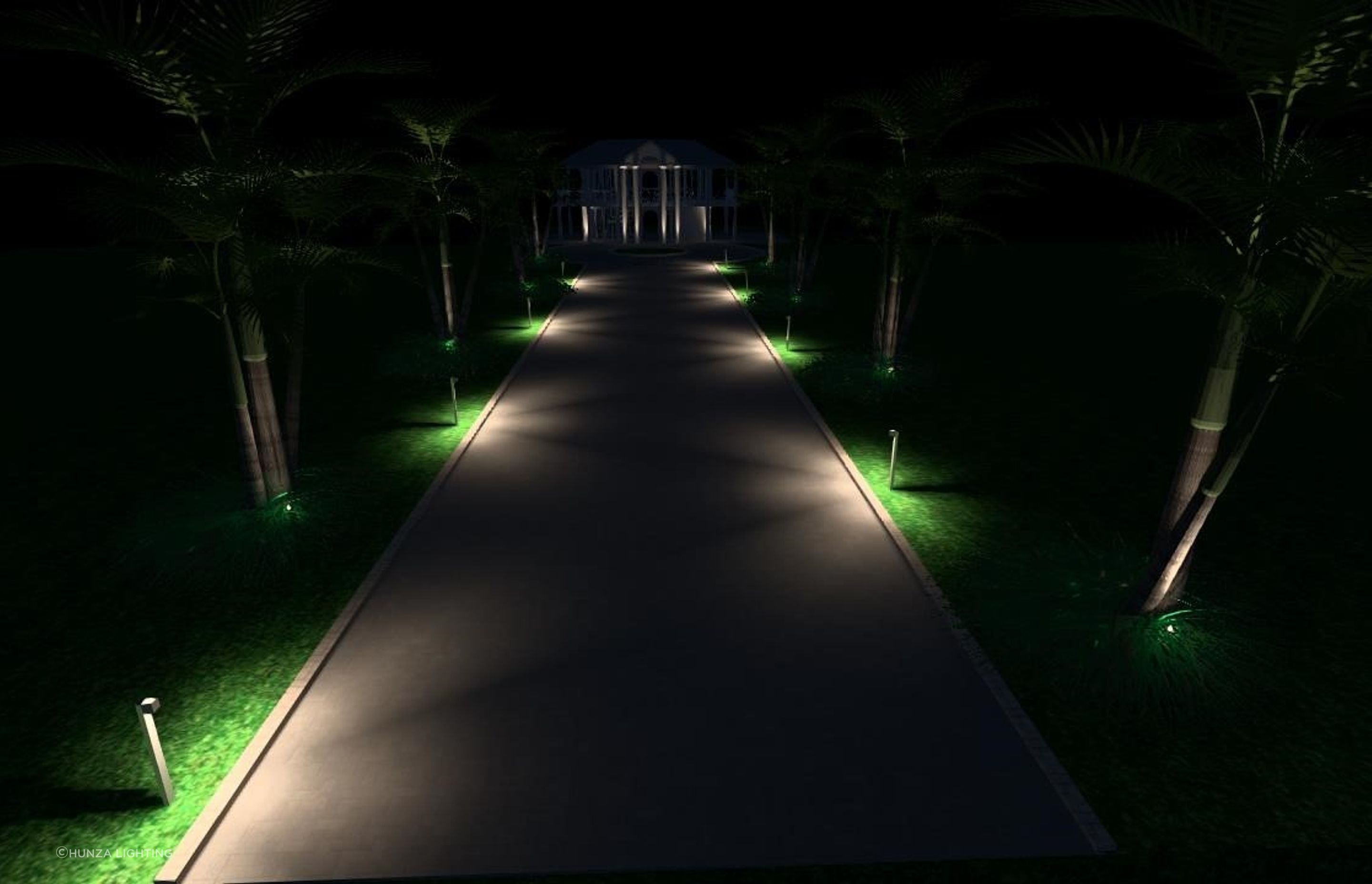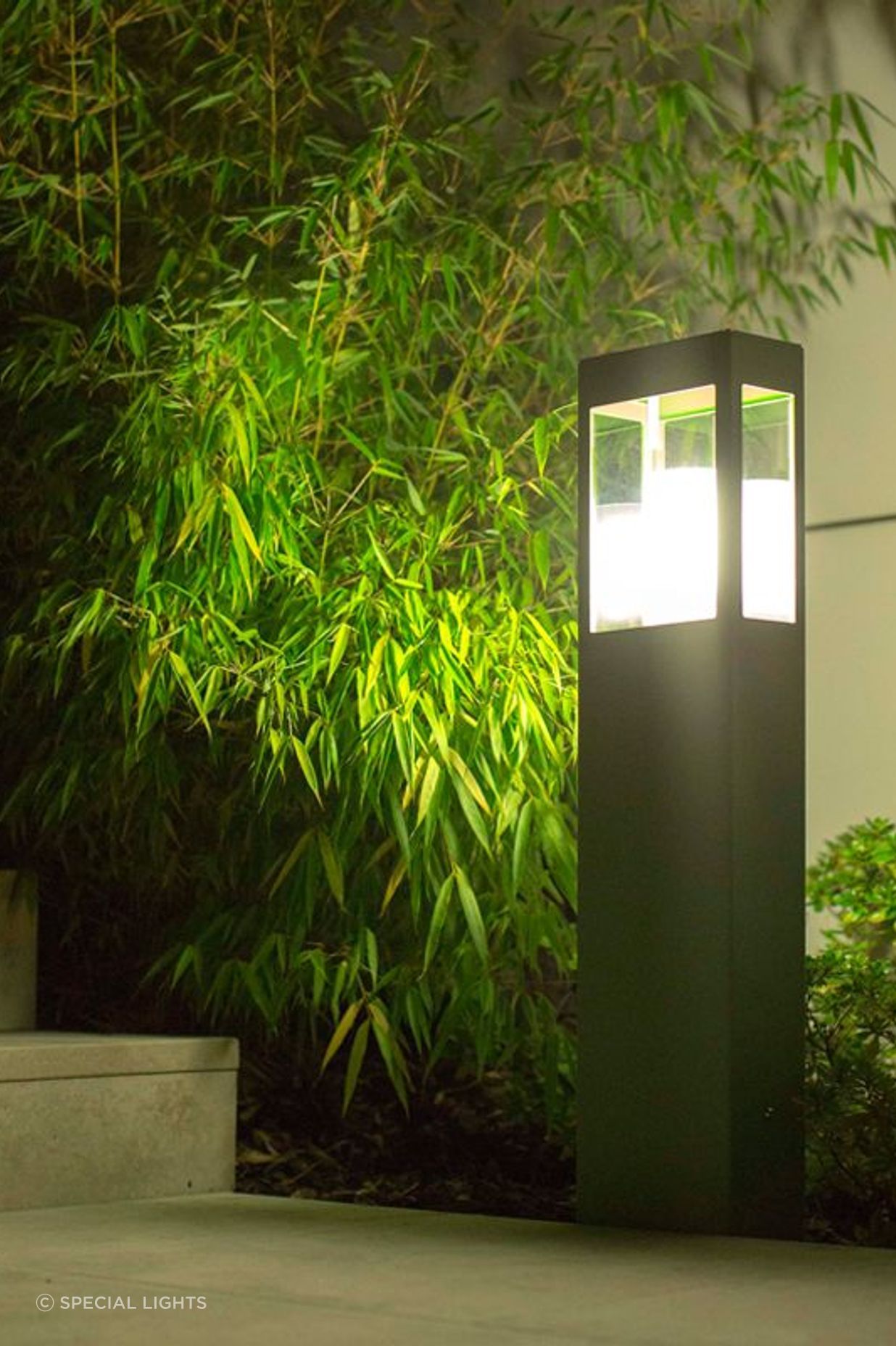Everything you need to know about bollard lights

Bollard lights (not to be confused with a post light) are a quick and easy way to add style and atmosphere to an outdoor living area. Not only do they provide great illumination when the sun goes down but they can look fantastic too when used in the right way.

What are bollard lights?
Bollard lights are a type of outdoor LED lighting, primarily for outdoor use. Historically, the term bollard referred to the posting used in marinas. They were used to moor boats to a harbour. This is why we see a similar shape between the two.
The bollard light is typically encased in a vertical post with a rounded top. However, with the popularity of bollard lighting, you can now get bollards in all shapes and sizes to suit your own style.

Types of bollard lighting
Louvre bollard lights
As the name suggests, louvre bollard lights showcase their louvered design, which points light downwards. This makes them great if you need to illuminate pathways, gardens and other outdoor areas where you need to light the ground. The design also helps reduce glare which makes the light more comfortable for pedestrians and passers-by.
Standard cone reflector
This is the typical style of bollard light. It features a cone-shaped reflector that spreads light in a 360 degree pattern. The wide light spread makes them great for commercial settings, such as car parks, walkways and open public areas. This design highlights how bollard lights can be available in different shapes and styles.
Specialised cone reflector
Similar to the standard cone reflector but with a tweaked design, these bollards direct light both downwards and outwards. They provide excellent ground coverage without the glare, creating a pleasant lighting effect. This type is particularly suitable for areas where both visibility and atmosphere are important, such as outdoor dining areas, plazas, and pedestrian zones.
Type V glass reflector
This is the most intense kind of bollard lighting. It features a Type V glass reflector that provides an intense and extensive 360-degree light spread. Ideal for illuminating large open spaces, such junctions, and architectural settings. These lights are designed to distribute light evenly, effectively covering a wide area while minimising glare and hotspots.

How are outdoor bollard lights used?
Bollard lights work particularly well in outdoor settings because they offer a discrete yet easy way to enhance natural areas, demark land and provide walkway lighting.
They are often decorated with architectural and landscape elements such as filigree and moulding to embed them tastefully in gardens, public green spaces, and urban areas.
Industry expert Ellen Finch says: "A smart lighting scheme will always give your plot extra kerb appeal when night falls."
Related article: 7 garden lights that are simply magical
How do you choose the right bollard lights for your needs?
There's plenty to consider to ensure you choose the right bollard lights for your setting. Here are the key things to consider:
What's the purpose?
When you’re thinking about the purpose of why you’re considering bollard lighting, it's important to get clear on the specific needs of the area. For areas where safety and visibility are priority, especially in areas like walkways, entrances, or driveways, selecting bollards that offer strong and clear lighting is important e.g. standard cone reflector bollard lights; this ensures pathways are well-lit to prevent accidents.
If the objective is to enhance the design, layout and look of an area, such as a garden or patio, choosing bollards with an appealing design and softer lighting can create a welcoming atmosphere. For security-focused applications, bollards with higher intensity lighting and integrated features like motion sensors can be an effective choice, as they provide bright illumination and can deter unwanted visitors.
Getting as clear as possible on why you need bollard lights will help you choose the best type that caters to your needs.
What style do you want?
Think about whether you want your bollard lights to match the architectural style of your property. For example, If your property features a contemporary design with minimalist architecture, characterised by clean lines and a neutral colour palette, you might choose bollard lights that are sleek and simple in design. A good example would be slim, cylindrical LED bollard lights with a matte black or stainless steel finish.
Think about the IP rating
The IP (Ingress Protection) rating of a bollard light is crucial as it indicates the fixture's resistance to dust and water. Typically, for outdoor bollard lights, an ip rating of IP44 or higher is what you want to look for. A rating of IP44 or higher means the light is protected against solid objects larger than 1mm (like wires or screws) and water splashing from any direction. If the bollard lights are to be used in an area with heavy rain or irrigation, consider a higher rating, such as IP65, which offers dust-tight protection and resistance to water jets.
Consider brightness
Brightness levels are key for bollard lights depending on their application. For example, pathway lighting typically requires 100-200 lumens, while driveways and high-visibility areas benefit from 300-400 lumens. Colour temperature is also key: 3000K for a warm, welcoming glow in gardens, and 5000K for clearer, security-enhancing colour temperature in driveways.
Consider budget
Of course, your budget is key to consider. The amount you spend will likely come down to the number of lights you need, the type you go for, and the specific brand. Keep in mind how much you want to spend before you start shopping, or seek a professional to get a quote for accurate pricing.
The benefits of bollard lighting
According to aestheticians, bollard lighting is a way to designate the purpose and identity of a space, really bringing an area to life. Not least because bollard lighting can:
- Enhance natural features
- Light walkways
- Accentuate architectural features
- Brighten driveways
- Border property lines
- Create a layout for your landscape design
- Create ambience
- Improve security
Since bollard lights use LEDs, you can benefit from a long life expectancy, improved environmental efficiency and many design customisations.
You can choose the colour, material, and design of your bollards to match your space's modern, traditional or commercial style. Not to mention, since they're designed for the outdoors, they'll be resilient and durable against the elements.

What do bollard lights cost?
The cost of bollard lighting will depend on the size and application of your project.
Unit cost
For one bollard light, the unit cost can be between $80-300+ depending on the material.
However, typically bollard lights can be bought in bulk at a discounted price. For example, the cost of 10 bollard lights at a wholesale price can be between $400-1000+ depending on the material.
It's a good idea to shop around to get the best deal. Or consider asking a landscaper who may be able to get discounted prices for you.
Installation cost
It's also worth considering the cost of installation for your lighting. To hire an hourly contractor, you could be looking at: $80/hr to $120/hr depending on your location and the reputation, skill and experience of the professional.
Running/maintenance costs
Bollard lighting typically uses 50W to 150W depending on brightness and efficiency. For example, if you were running a 70W bollard light, you could expect to run a cost of approximately $63 per lamp. If you had 10 lamps, that could be around $630 per year in electric charges.
Suppose you intend for your light to be used in a commercial setting. In that case, you will have to account for potential damage and interference. The cost for these lights can be as much as $550 in labour and material to maintain a single exterior bollard fixture over three years.
That being said, you can also get bollards that are solar lights too which won’t have any power consumption charges at all.

Light coverage
Different lights emit different amounts of coverage and brightness. If you want to illuminate an entire area, you'll have to ensure an adequate distance between your bollards.
The light also needs to be bright enough to reach the next point and account for the size of your bollard. Typically smaller bollards will have less coverage than the larger variety.
The light range of a small bollard can be between 40-60cm. Whereas larger bollards will reach up to 120cm.
Related article: 11 outdoor lighting ideas to up the ambience
Power
You'll also have to decide where to locate your power source, and this, in turn, will affect the placement of your bollards. To determine the correct source, you will need to know how much power the bollards require.
Usually, a technician will be able to help you with this. However, they'll need either hooking up directly to the main supply lines or to a generator of some kind that can be connected to a standard indoor or outdoor plug socket.

Property lines
If you plan to use your bollards to mark your property lines, you'll need to familiarise yourself with government regulations on property boundaries.
This will tell you about your obligations to neighbours and the legal restrictions that may apply.
If your lighting will be seen by your neighbours, such as if it is in the front of your property, it may be worth discussing with them to ensure they are happy with the arrangement.
Moreover, you may need to conduct a survey to prepare for the layout of your boundary.
Are you ready to start using bollard lights?
There are many things to consider when choosing the best outdoor lighting for your space. As you can see, bollard lights provide a strong case as an outdoor lighting solution as a great way to provide ambience, match your aesthetic and suit your practical needs.
Related article: 11 of the best outdoor lighting trends for 2023
